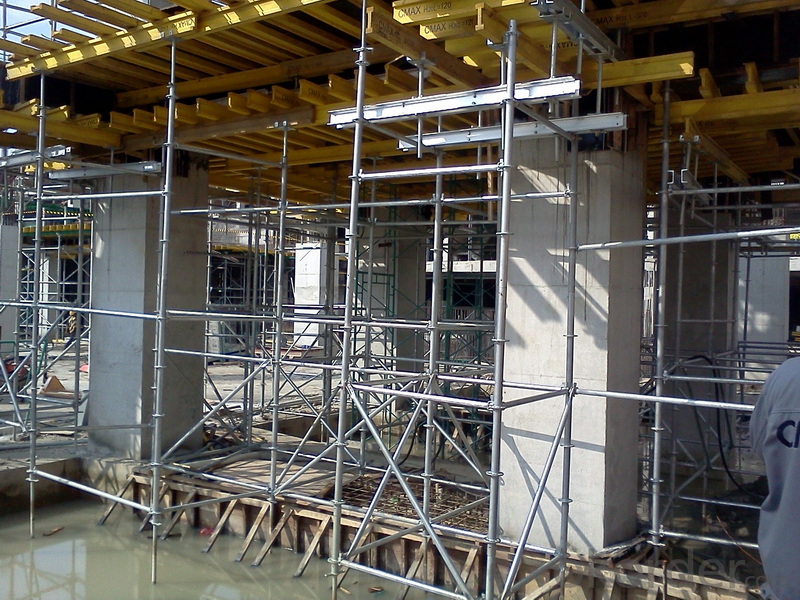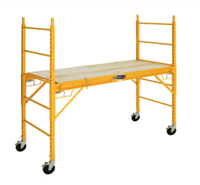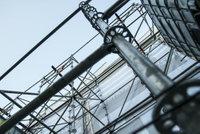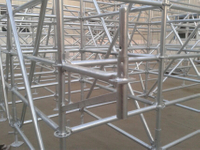Content Menu
● Introduction to Cuplock Scaffolding
● Key Components of Standard Cuplock Scaffolding
● Accessories and Additional Components
● Assembly and Installation of Cuplock Scaffolding
● Applications of Standard Cuplock Scaffolding
● Advantages of Cuplock Scaffolding
● Safety Considerations
● Safety Inspection Checklist
● Maintenance and Storage
● Comparison with Other Scaffolding Systems
● Comparison Table
● Conclusion
● FAQ
>> 1. What is the primary material used for cuplock scaffolding components?
>> 2. How does the cuplock mechanism work?
>> 3. What are the main applications of standard cuplock scaffolding?
>> 4. What safety measures should be taken when using cuplock scaffolding?
>> 5. How does cuplock scaffolding compare to traditional scaffolding systems?
● Citations:
Cuplock scaffolding is a widely used modular scaffolding system, known for its ease of assembly, durability, and versatility. It is commonly employed in construction, industrial, commercial, and structural applications. The system's unique locking mechanism allows for quick and secure connection of components, making it a preferred choice for various projects. In this article, we will delve into the identification and understanding of standard cuplock scaffolding components, along with their functions and applications.

Introduction to Cuplock Scaffolding
Cuplock scaffolding is characterized by its modular design, which includes a unique circular cup-node point that connects up to four scaffolding horizontal components with a vertical component in a single installation. The absence of loose components and the galvanized finish contribute to its robust and durable performance. The locking mechanism consists of a fixed bottom cup and a sliding top cup, which securely locks components with a single hammer stroke, eliminating the need for loose clips, screws, or wedges.
Key Components of Standard Cuplock Scaffolding
The main components of standard cuplock scaffolding include:
- Cuplock Standards: These are the vertical members of the system, positioned with a lower cup at 0.5m intervals and fixed with a rotatable top cup.
- Ledgers: These are the horizontal members that support the overall system, secured with vertical tubes to ensure a solid framework assembly.
- Intermediate Transoms: Provide mid-bay support to scaffold boards between internal and external ledgers.
- Cantilever Frames: Extend the reach of the scaffolding system beyond its normal base structure.
Accessories and Additional Components
In addition to the main components, standard cuplock scaffolding also includes several accessories:
- Base Plates: Distribute the load of the scaffold evenly across the ground.
- Decking Beams and Infill Beams: Support the deck or platform and fill gaps in complex geometries.
- Drop Heads: Facilitate quick dismantling by removing decking beams without impacting vertical load-bearing elements.
- Round Spigots and Spigot Bolt Nuts: Extend the vertical reach of the structure through end-to-end connections.
- Unit Beams: Span larger distances to support heavy loads.
Assembly and Installation of Cuplock Scaffolding
The assembly of cuplock scaffolding is straightforward due to its modular design. Here's a simplified step-by-step guide:
1. Prepare the Site: Ensure the ground is level and stable.
2. Lay Base Plates: Position base plates to distribute the weight evenly.
3. Erect Standards: Place vertical standards on base plates.
4. Install Ledgers: Connect horizontal ledgers to standards using the cuplock mechanism.
5. Add Intermediate Transoms: Provide mid-bay support for scaffold boards.
6. Secure with Braces: Use diagonal braces for additional stability.

Applications of Standard Cuplock Scaffolding
Cuplock scaffolding is versatile and can be used in a variety of applications:
- Building Construction: Supports formwork and provides access for construction workers.
- Event Staging: Used for temporary stages and platforms.
- Infrastructure Projects: Ideal for bridge maintenance and repair.
- Facilities Maintenance: Offers safe access for maintenance tasks.
Advantages of Cuplock Scaffolding
- Easy Assembly: Components lock into place quickly without loose parts.
- Durability: Galvanized finish ensures resistance to corrosion.
- Versatility: Adaptable to different construction needs.
- Cost-Effective: Saves time and reduces long-term maintenance costs.
Safety Considerations
Safety is paramount when using cuplock scaffolding. Ensure that:
- All components are properly secured.
- The structure is level and stable.
- Regular inspections are conducted to identify any wear or damage.
For comprehensive safety guidelines, refer to industry standards such as EN 12810.
Safety Inspection Checklist
1. Component Condition: Check for any signs of wear or damage.
2. Assembly Integrity: Verify that all components are securely locked.
3. Load Capacity: Ensure the structure does not exceed its load capacity.
Maintenance and Storage
Proper maintenance and storage of cuplock scaffolding components are crucial for extending their lifespan:
- Clean Components: Regularly clean components to prevent dirt buildup.
- Store in Dry Conditions: Store scaffolding in a dry area to prevent rust.
- Inspect Before Use: Always inspect components before reusing them.
Comparison with Other Scaffolding Systems
Cuplock scaffolding offers several advantages over traditional scaffolding systems:
- Lightweight: Easier to transport and assemble.
- Modular Design: Allows for quick reconfiguration.
- Cost-Effective: Reduces labor costs due to faster assembly times.
Comparison Table
| Feature | Cuplock Scaffolding | Traditional Scaffolding |
| Assembly Time | Faster | Slower |
| Weight | Lighter | Heavier |
| Versatility | Higher | Lower |
| Cost-Effectiveness | Higher | Lower |
Conclusion
Standard cuplock scaffolding components are designed to provide a robust, efficient, and safe working platform for various construction and maintenance projects. Understanding these components and their functions is crucial for effective assembly and use. By leveraging the advantages of cuplock scaffolding, projects can be completed more efficiently while ensuring the safety of workers.

FAQ
1. What is the primary material used for cuplock scaffolding components?
Cuplock scaffolding components are typically made from galvanized steel, such as Q355 pipe, which provides durability and resistance to corrosion.
2. How does the cuplock mechanism work?
The cuplock mechanism involves a fixed bottom cup and a sliding top cup. The top cup is rotated to lock horizontal components onto the vertical standards, securing them with a single hammer stroke.
3. What are the main applications of standard cuplock scaffolding?
Standard cuplock scaffolding is used in building construction, event staging, infrastructure projects, and facilities maintenance due to its versatility and adaptability.
4. What safety measures should be taken when using cuplock scaffolding?
Ensure all components are properly secured, the structure is level and stable, and conduct regular inspections to identify any wear or damage.
5. How does cuplock scaffolding compare to traditional scaffolding systems?
Cuplock scaffolding is lighter, easier to assemble, and more cost-effective than traditional systems, saving up to 50% of construction time.
Citations:
[1] https://www.scaxa.ae/scaffolding/types/cuplock/
[2] https://www.youtube.com/watch?v=wBKilb9ALEY
[3] https://rapid-scafform.com/cuplock-scaffold/
[4] https://www.alibaba.com/showroom/cuplock-scaffolding.html
[5] https://www.affixscaffolding.com/wp-content/uploads/2022/03/Affix-Cuplock-Manual.pdf
[6] https://www.youtube.com/watch?v=fnJw0xLZE5s
[7] https://www.wm-scaffold.com/cup-lock-scaffold.html
[8] https://www.sparsteel.com/blog/cuplock-scaffolding-types-uses-and-benefits/
[9] https://jumplyscaffolding.com/what-is-cuplock-scaffolding/
[10] https://www.youtube.com/watch?v=l7SdKkdbeU4
[11] https://patents.google.com/patent/CN202416822U/en






















